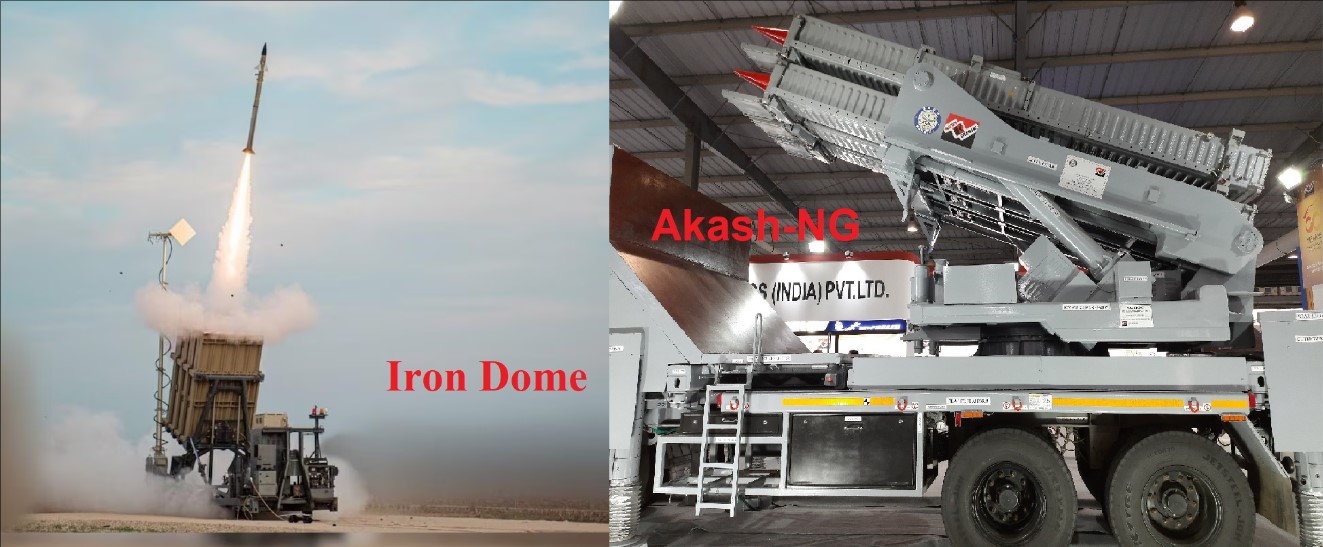How India’s Akash NG Air Defense System Surpasses Israel’s Iron Dome in Advanced Capabilities

India’s Akash NG (Next Generation) air defense system and Israel’s Iron Dome system are both designed to protect against aerial threats, but they cater to different types of threats and operational scenarios, making them suited to distinct battlefield environments. The Akash NG is a medium-range surface-to-air missile (SAM) system, whereas the Iron Dome is a short-range system specifically designed to counter rocket and artillery threats. Understanding how the Akash NG is more advanced requires looking at their capabilities, scope of protection, and the technology behind each system.
Range and Types of Threats
The Akash NG system is designed to intercept a variety of aerial threats such as fighter jets, cruise missiles, and drones over a much broader range than the Iron Dome. The Akash NG has an effective range of around 30-40 km and can engage targets at altitudes up to 20-25 km, making it ideal for engaging high-speed and high-altitude threats, including advanced fighter aircraft or ballistic missiles.
On the other hand, the Iron Dome is specifically tailored for defending against short-range rockets, artillery, and mortar rounds, with a range of around 4-70 km. It is optimized to deal with slower-moving, lower-altitude projectiles, making it perfect for countering threats like incoming rockets fired from relatively close distances, such as those encountered by Israel from Gaza.
In terms of versatility, the Akash NG is more advanced due to its ability to handle supersonic aerial threats at varying altitudes, while the Iron Dome is specialized for intercepting slower, more predictable trajectories of rocket or mortar fire.
Interceptor Missiles and Guidance Technology
The Akash NG uses an active radar seeker for precision guidance, significantly enhancing its ability to track and engage multiple targets with greater accuracy. The active seeker allows the missile to adjust its path mid-flight, giving it better agility and effectiveness against modern fighter aircraft and other agile threats. Additionally, the Akash NG's integration of a two-pulse solid rocket motor increases its speed and range, allowing for better engagement of fast, maneuvering targets.
Iron Dome’s Tamir interceptors use radar and electro-optic sensors to target and destroy incoming rockets in their terminal phase. While highly efficient in intercepting low-speed projectiles, the Iron Dome’s missiles are not built for engaging fast-moving, high-altitude threats. The system prioritizes cost efficiency by only engaging those projectiles on a course to hit populated areas, conserving resources in areas of intense conflict.
In comparison, Akash NG's missiles are more advanced in terms of speed, agility, and range. It can handle threats that move faster and higher than those targeted by Iron Dome, making Akash NG a more comprehensive air defense system in terms of aerial combat scenarios.
Mobility and Flexibility
Another key area where Akash NG demonstrates advanced capabilities is in its mobility and deployment flexibility. The Akash NG system is mounted on a high-mobility vehicle, making it capable of quick repositioning across a variety of terrains. This makes it well-suited for large-scale battlefield operations, defending against aerial threats across vast areas.
The Iron Dome, while mobile, is generally deployed around cities or military installations to protect against concentrated rocket fire. It is not designed to be repositioned quickly in the midst of combat, as its role is more static, focused on fixed-point defense in regions facing high risks of rocket attacks.
Strategic and Operational Differences
The Akash NG serves a broader strategic purpose. Its integration into the Indian Air Force and Indian Army’s air defense networks is aimed at providing a layered defense against aerial threats in the context of conventional warfare, particularly on contested borders with Pakistan and China. It’s part of India’s larger air defense strategy, which also includes systems like the S-400 and Barak-8 for longer-range defense.
The Iron Dome, in contrast, is primarily a defensive shield against irregular warfare tactics, such as the barrage of short-range rockets or mortars fired by groups like Hamas or Hezbollah. It is a part of Israel’s multi-tiered missile defense shield but is specifically tailored for low-cost, high-volume projectile threats.
Technological Edge
In terms of technological advancements, Akash NG is equipped with a state-of-the-art radar system capable of simultaneously tracking and engaging multiple high-speed targets, including modern aircraft equipped with countermeasures like electronic jamming or evasive maneuvers. The Akash NG’s long-range surveillance radar and fire control radar are highly sophisticated, making it capable of handling a more complex threat environment.
The Iron Dome is technologically advanced in its own right, especially in its ability to predict the impact points of incoming rockets and make decisions about which ones to intercept. However, it is not designed to counter advanced fighter jets, cruise missiles, or other sophisticated high-speed threats.
In summary, while both the Akash NG and the Iron Dome are cutting-edge systems, their differences reflect their specialized roles. The Akash NG is more advanced in terms of range, versatility, and the types of threats it can neutralize. It is built for high-speed, high-altitude aerial warfare, engaging enemy aircraft and missiles over greater distances and with higher precision. The Iron Dome, while immensely successful in its domain, is optimized for short-range, low-altitude projectile threats and serves a more focused defensive role. For nations like India, which face diverse and sophisticated aerial threats, the Akash NG represents a more comprehensive air defense capability.


